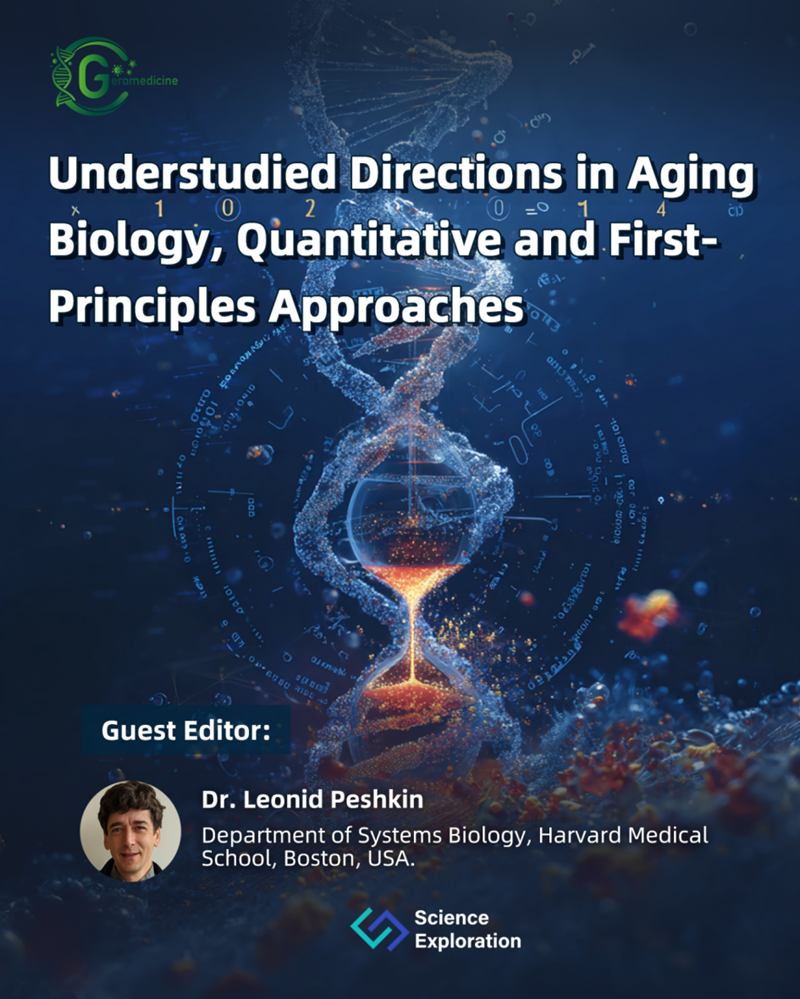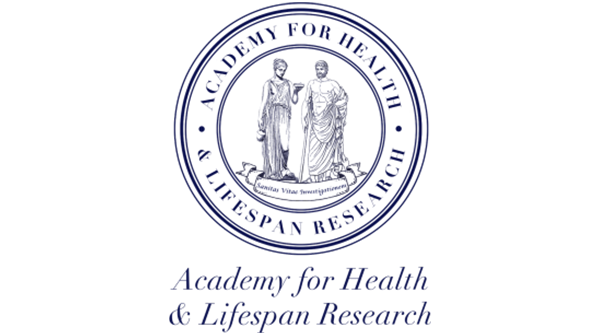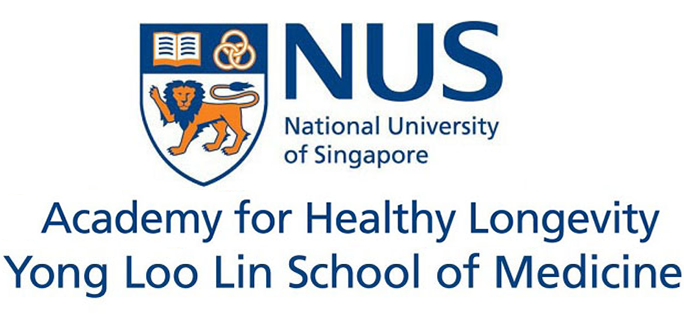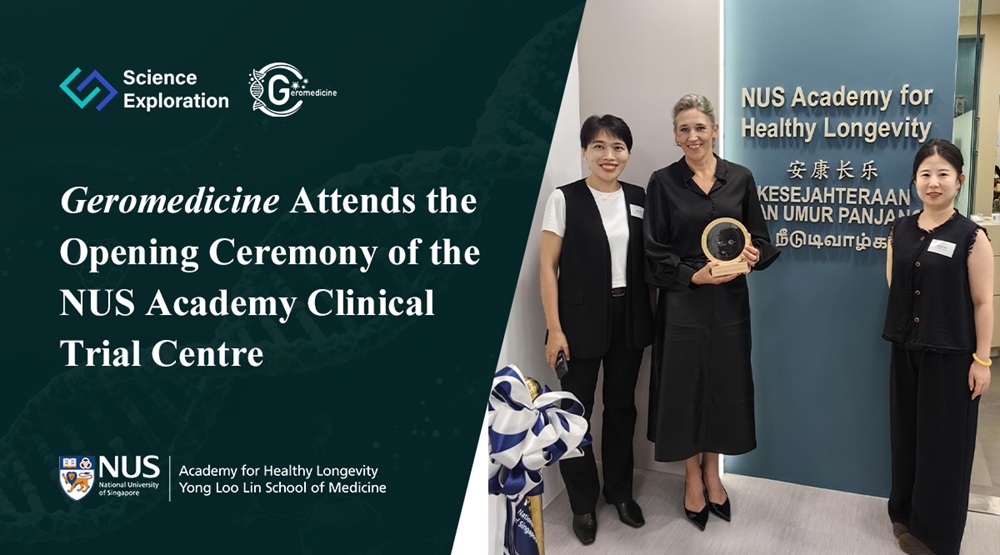
-
Geromedicine is a quarterly, gold open-access journal published by Science Exploration Press, offering a comprehensive platform for research in geroscience. Progress in geroscience - the study of aging - has laid the foundation for geromedicine, which focuses on evidence-based medical interventions to keep individuals and populations healthy and fit. Precision geromedicine will rely on aging biomarkers to assess an individual's biological aging process (gerodiagnosis) and apply targeted interventions to enhance health and longevity (gerotherapeutics). The new journal Geromedicine will lead the development of this emerging medical discipline. more >
Articles
Hallmarks of aging: Integrating molecular and social determinants
-
The biology of aging is increasingly understood through geroscience frameworks integrating molecular, cellular, physiological, and social hallmarks. Recently, we introduced psychosocial factors including mental illness as an important hallmark of ...
MoreThe biology of aging is increasingly understood through geroscience frameworks integrating molecular, cellular, physiological, and social hallmarks. Recently, we introduced psychosocial factors including mental illness as an important hallmark of aging. Indeed, exposome-centered approaches reveal complex interactions among socioeconomic, environmental, behavioral, and genomic factors. Precision Geromedicine aims to target all these determinants in a holistic fashion to improve aging trajectories and extend healthspan.
Less -
Carlos López-Otín, Guido Kroemer
-
DOI: https://doi.org/10.70401/Geromedicine.2025.0007 - October 31, 2025
Tau protein isoforms in neuropathological aging: Gerosuppressors, gerogenes or just travel companions
-
In recent years, the terms “gerosuppressors” and “gerogenes” have been introduced to describe factors that respectively delay or accelerate aging. These factors are present across various cell types. Specific proteins, such as tau predominantly expressed ...
MoreIn recent years, the terms “gerosuppressors” and “gerogenes” have been introduced to describe factors that respectively delay or accelerate aging. These factors are present across various cell types. Specific proteins, such as tau predominantly expressed in neurons, may act as neuron-specific gerosuppressors or gerogenes. Tau exhibits a dual role influenced by its post-translational modifications, particularly phosphorylation. In this review, we discuss relevant examples of tau isoforms that demonstrate both roles, underscoring its dual influence on neuronal aging.
Less -
Jesús Avila, ... José Viña
-
DOI: https://doi.org/10.70401/Geromedicine.2025.0006 - October 17, 2025
Autophagy in age-related liver disease
-
Aging profoundly impacts liver physiology by disrupting autophagy, a lysosome-dependent degradation pathway essential for maintaining cellular homeostasis. Autophagy declines with aging due to reduced expression of core autophagy-related (ATG) genes/proteins, ...
MoreAging profoundly impacts liver physiology by disrupting autophagy, a lysosome-dependent degradation pathway essential for maintaining cellular homeostasis. Autophagy declines with aging due to reduced expression of core autophagy-related (ATG) genes/proteins, defective autophagosome fusion, and impaired selective processes such as lipophagy, mitophagy, and chaperone-mediated autophagy. These alterations contribute to lipid accumulation, oxidative stress, inflammation, and mitochondrial dysfunction, thereby accelerating age-related liver diseases including metabolic-associated fatty liver disease (MAFLD), fibrosis, and hepatocellular carcinoma (HCC). Their molecular mechanisms involve deregulation of nutrient-sensing pathways (mTOR complex 1, AMP-activated protein kinase and sirtuin 1 and 3) and context-dependent roles of autophagy-related proteins (ATG5, ATG7, LC3, Beclin-1, LAMP2A). Importantly, the regulatory role of autophagy differs across disease stages related to liver aging. During early phases, it maintains metabolic balance, mitochondrial quality control, and genomic stability in some diseases such as MAFLD and liver fibrosis. Conversely, in advanced disease, particularly in HCC, persistent autophagy supports tumor cell survival, stemness, and immune evasion. Emerging therapies seek to restore autophagic flux through caloric restriction, physical exercise, caloric restriction mimetics (rapalogs, spermidine, metformin), and pharmacological modulators such as Tat-BECLIN-1 peptides or RUBICON-targeted approaches. However, translating these therapies into clinical practice remains challenging due to systemic effects, stage-specific responses, and lack of reliable non-invasive biomarkers for monitoring autophagy in humans. Advances in nanoparticle-based delivery, biomarker-guided stratification, and combination therapies with tyrosine kinase inhibitors or immune checkpoint inhibitors may offer promising strategies. Overall, precision modulation of autophagy could serve as a potent geroprotective approach to preserve liver function, delay age-related metabolic deterioration, and prevent progression to fibrosis and cancer. Achieving this goal requires considering disease stage, systemic interactions, and autophagy’s context-dependent duality in aging when implementing these strategies.
Less -
Roberto Palacios-Ramírez, ... Omar Motiño García-Miguel
-
DOI: https://doi.org/10.70401/Geromedicine.2025.0005 - October 17, 2025
Education in Healthy Longevity as a prerequisite for a new healthcare model
-
Hans J. Meij, ... Guido Kroemer
-
DOI: https://doi.org/10.70401/Geromedicine.2025.0004 - September 30, 2025
Inserm-sponsored aging research in France
-
Eric Gilson
-
DOI: https://doi.org/10.70401/Geromedicine.2025.0003 - September 05, 2025
The vocabulary of geromedicine: gerovocabulary
-
Guido Kroemer, ... Andrea B. Maier
-
DOI: https://doi.org/10.70401/Geromedicine.2025.0002 - May 07, 2025
Geromedicine: A new journal for the clinical application of geroscience
-
Guido Kroemer, ... Andrea B. Maier
-
DOI: https://doi.org/10.70401/Geromedicine.2025.0001 - May 07, 2025
Hallmarks of aging: Integrating molecular and social determinants
-
The biology of aging is increasingly understood through geroscience frameworks integrating molecular, cellular, physiological, and social hallmarks. Recently, we introduced psychosocial factors including mental illness as an important hallmark of ...
MoreThe biology of aging is increasingly understood through geroscience frameworks integrating molecular, cellular, physiological, and social hallmarks. Recently, we introduced psychosocial factors including mental illness as an important hallmark of aging. Indeed, exposome-centered approaches reveal complex interactions among socioeconomic, environmental, behavioral, and genomic factors. Precision Geromedicine aims to target all these determinants in a holistic fashion to improve aging trajectories and extend healthspan.
Less -
Carlos López-Otín, Guido Kroemer
-
DOI: https://doi.org/10.70401/Geromedicine.2025.0007 - October 31, 2025
Education in Healthy Longevity as a prerequisite for a new healthcare model
-
Hans J. Meij, ... Guido Kroemer
-
DOI: https://doi.org/10.70401/Geromedicine.2025.0004 - September 30, 2025
Autophagy in age-related liver disease
-
Aging profoundly impacts liver physiology by disrupting autophagy, a lysosome-dependent degradation pathway essential for maintaining cellular homeostasis. Autophagy declines with aging due to reduced expression of core autophagy-related (ATG) genes/proteins, ...
MoreAging profoundly impacts liver physiology by disrupting autophagy, a lysosome-dependent degradation pathway essential for maintaining cellular homeostasis. Autophagy declines with aging due to reduced expression of core autophagy-related (ATG) genes/proteins, defective autophagosome fusion, and impaired selective processes such as lipophagy, mitophagy, and chaperone-mediated autophagy. These alterations contribute to lipid accumulation, oxidative stress, inflammation, and mitochondrial dysfunction, thereby accelerating age-related liver diseases including metabolic-associated fatty liver disease (MAFLD), fibrosis, and hepatocellular carcinoma (HCC). Their molecular mechanisms involve deregulation of nutrient-sensing pathways (mTOR complex 1, AMP-activated protein kinase and sirtuin 1 and 3) and context-dependent roles of autophagy-related proteins (ATG5, ATG7, LC3, Beclin-1, LAMP2A). Importantly, the regulatory role of autophagy differs across disease stages related to liver aging. During early phases, it maintains metabolic balance, mitochondrial quality control, and genomic stability in some diseases such as MAFLD and liver fibrosis. Conversely, in advanced disease, particularly in HCC, persistent autophagy supports tumor cell survival, stemness, and immune evasion. Emerging therapies seek to restore autophagic flux through caloric restriction, physical exercise, caloric restriction mimetics (rapalogs, spermidine, metformin), and pharmacological modulators such as Tat-BECLIN-1 peptides or RUBICON-targeted approaches. However, translating these therapies into clinical practice remains challenging due to systemic effects, stage-specific responses, and lack of reliable non-invasive biomarkers for monitoring autophagy in humans. Advances in nanoparticle-based delivery, biomarker-guided stratification, and combination therapies with tyrosine kinase inhibitors or immune checkpoint inhibitors may offer promising strategies. Overall, precision modulation of autophagy could serve as a potent geroprotective approach to preserve liver function, delay age-related metabolic deterioration, and prevent progression to fibrosis and cancer. Achieving this goal requires considering disease stage, systemic interactions, and autophagy’s context-dependent duality in aging when implementing these strategies.
Less -
Roberto Palacios-Ramírez, ... Omar Motiño García-Miguel
-
DOI: https://doi.org/10.70401/Geromedicine.2025.0005 - October 17, 2025
The vocabulary of geromedicine: gerovocabulary
-
Guido Kroemer, ... Andrea B. Maier
-
DOI: https://doi.org/10.70401/Geromedicine.2025.0002 - May 07, 2025
Hallmarks of aging: Integrating molecular and social determinants
-
The biology of aging is increasingly understood through geroscience frameworks integrating molecular, cellular, physiological, and social hallmarks. Recently, we introduced psychosocial factors including mental illness as an important hallmark of ...
MoreThe biology of aging is increasingly understood through geroscience frameworks integrating molecular, cellular, physiological, and social hallmarks. Recently, we introduced psychosocial factors including mental illness as an important hallmark of aging. Indeed, exposome-centered approaches reveal complex interactions among socioeconomic, environmental, behavioral, and genomic factors. Precision Geromedicine aims to target all these determinants in a holistic fashion to improve aging trajectories and extend healthspan.
Less -
Carlos López-Otín, Guido Kroemer
-
DOI: https://doi.org/10.70401/Geromedicine.2025.0007 - October 31, 2025
Geromedicine: A new journal for the clinical application of geroscience
-
Guido Kroemer, ... Andrea B. Maier
-
DOI: https://doi.org/10.70401/Geromedicine.2025.0001 - May 07, 2025
Autophagy in age-related liver disease
-
Aging profoundly impacts liver physiology by disrupting autophagy, a lysosome-dependent degradation pathway essential for maintaining cellular homeostasis. Autophagy declines with aging due to reduced expression of core autophagy-related (ATG) genes/proteins, ...
MoreAging profoundly impacts liver physiology by disrupting autophagy, a lysosome-dependent degradation pathway essential for maintaining cellular homeostasis. Autophagy declines with aging due to reduced expression of core autophagy-related (ATG) genes/proteins, defective autophagosome fusion, and impaired selective processes such as lipophagy, mitophagy, and chaperone-mediated autophagy. These alterations contribute to lipid accumulation, oxidative stress, inflammation, and mitochondrial dysfunction, thereby accelerating age-related liver diseases including metabolic-associated fatty liver disease (MAFLD), fibrosis, and hepatocellular carcinoma (HCC). Their molecular mechanisms involve deregulation of nutrient-sensing pathways (mTOR complex 1, AMP-activated protein kinase and sirtuin 1 and 3) and context-dependent roles of autophagy-related proteins (ATG5, ATG7, LC3, Beclin-1, LAMP2A). Importantly, the regulatory role of autophagy differs across disease stages related to liver aging. During early phases, it maintains metabolic balance, mitochondrial quality control, and genomic stability in some diseases such as MAFLD and liver fibrosis. Conversely, in advanced disease, particularly in HCC, persistent autophagy supports tumor cell survival, stemness, and immune evasion. Emerging therapies seek to restore autophagic flux through caloric restriction, physical exercise, caloric restriction mimetics (rapalogs, spermidine, metformin), and pharmacological modulators such as Tat-BECLIN-1 peptides or RUBICON-targeted approaches. However, translating these therapies into clinical practice remains challenging due to systemic effects, stage-specific responses, and lack of reliable non-invasive biomarkers for monitoring autophagy in humans. Advances in nanoparticle-based delivery, biomarker-guided stratification, and combination therapies with tyrosine kinase inhibitors or immune checkpoint inhibitors may offer promising strategies. Overall, precision modulation of autophagy could serve as a potent geroprotective approach to preserve liver function, delay age-related metabolic deterioration, and prevent progression to fibrosis and cancer. Achieving this goal requires considering disease stage, systemic interactions, and autophagy’s context-dependent duality in aging when implementing these strategies.
Less -
Roberto Palacios-Ramírez, ... Omar Motiño García-Miguel
-
DOI: https://doi.org/10.70401/Geromedicine.2025.0005 - October 17, 2025
Tau protein isoforms in neuropathological aging: Gerosuppressors, gerogenes or just travel companions
-
In recent years, the terms “gerosuppressors” and “gerogenes” have been introduced to describe factors that respectively delay or accelerate aging. These factors are present across various cell types. Specific proteins, such as tau predominantly expressed ...
MoreIn recent years, the terms “gerosuppressors” and “gerogenes” have been introduced to describe factors that respectively delay or accelerate aging. These factors are present across various cell types. Specific proteins, such as tau predominantly expressed in neurons, may act as neuron-specific gerosuppressors or gerogenes. Tau exhibits a dual role influenced by its post-translational modifications, particularly phosphorylation. In this review, we discuss relevant examples of tau isoforms that demonstrate both roles, underscoring its dual influence on neuronal aging.
Less -
Jesús Avila, ... José Viña
-
DOI: https://doi.org/10.70401/Geromedicine.2025.0006 - October 17, 2025
Special Issues
Understudied Directions in Aging Biology, Quantitative and First-Principles Approaches
-
Submission Deadline: 31 Dec 2025
-
Published articles: 0








